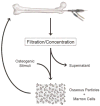Osteogenic potential of reamer irrigator aspirator (RIA) aspirate collected from patients undergoing hip arthroplasty
- PMID: 18655129
- PMCID: PMC2648608
- DOI: 10.1002/jor.20715
Osteogenic potential of reamer irrigator aspirator (RIA) aspirate collected from patients undergoing hip arthroplasty
Abstract
Intramedullary nailing preceded by canal reaming is the current standard of treatment for long-bone fractures requiring stabilization. However, conventional reaming methods can elevate intramedullary temperature and pressure, potentially resulting in necrotic bone, systemic embolism, and pulmonary complications. To address this problem, a reamer irrigator aspirator (RIA) has been developed that combines irrigation and suction for reduced-pressure reaming with temperature modulation. Osseous particles aspirated by the RIA can be recovered by filtration for use as an autograft, but the flow-through is typically discarded. The purpose of this study was to assess whether this discarded filtrate has osteogenic properties that could be used to enhance the total repair potential of aspirate. RIA aspirate was collected from five patients (ages 71-78) undergoing hip hemiarthroplasty. Osseous particles were removed using an open-pore filter, and the resulting filtrate (230 +/- 200 mL) was processed by Ficoll-gradient centrifugation to isolate mononuclear cells (6.2 +/- 5.2 x 10(6) cells/mL). The aqueous supernatant contained FGF-2, IGF-I, and latent TGF-beta1, but BMP-2 was below the limit of detection. The cell fraction included culture plastic-adherent, fibroblastic cells that displayed a surface marker profile indicative of mesenchymal stem cells and that could be induced along the osteogenic, adipogenic, and chondrogenic lineages in vitro. When compared to outgrowth cells from the culture of osseous particles, filtrate cells were more sensitive to seeding density during osteogenic culture but had similar capacity for chondrogenesis. These results suggest using RIA aspirate to develop improved, clinically expeditious, cost-effective technologies for accelerating the healing of bone and other musculoskeletal tissues.
Figures






References
-
- Christie J, Robinson CM, Pell AC, et al. Transcardiac echocardiography during invasive intramedullary procedures. J Bone Joint Surg Br. 1995;77:450–455. - PubMed
-
- Wenda K, Runkel M, Degreif J, et al. Pathogenesis and clinical relevance of bone marrow embolism in medullary nailing—demonstrated by intraoperative echocardiography. Injury. 1993;24(Suppl 3):S73–S81. - PubMed
-
- Pape HC, Auf’m’Kolk M, Paffrath T, et al. Primary intramedullary femur fixation in multiple trauma patients with associated lung contusion—a cause of posttraumatic ARDS? J Trauma. 1993;34:540–547. discussion 547–548. - PubMed
-
- Mueller CA, Green J, Sudkamp NP. Physical and technical aspects of intramedullary reaming. Injury. 2006;37(Suppl 4):S39–S49. - PubMed
-
- Pape HC, Zelle BA, Hildebrand F, et al. Reamed femoral nailing in sheep: does irrigation and aspiration of intramedullary contents alter the systemic response? J Bone Joint Surg Am. 2005;87:2515–2522. - PubMed
Publication types
MeSH terms
Grants and funding
LinkOut - more resources
Full Text Sources
Other Literature Sources
Medical

